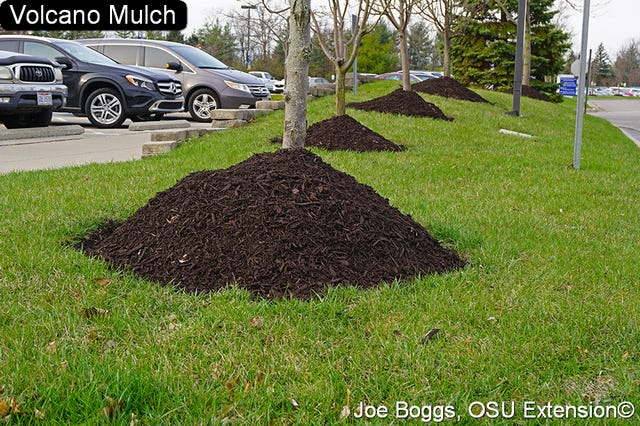All about mulch: Too much of a good thing is bad for your trees, shrubs and palnts

The smell of spring is in the air in Greater Columbus — not the smell of hyacinths or daffodils, but the smell of freshly applied hardwood mulch around trees and shrubs and other perennial plants. Unfortunately, many homeowners and landscapers pile mulch much deeper than necessary, a practice that is extremely harmful to trees, shrubs and even herbaceous perennials.
You've probably heard this before but it bears repeating: Mulch should never be deeper than 2 to 4 inches, regardless of the type of plants that are being mulched. Too often we see mulch “volcanoes” where mulch is piled in cones around trees to a depth of more than 18 inches.
Benefits of mulch
Applying mulch provides many benefits, including weed suppression, moderation of soil temperatures, moisture retention and the addition of organic matter and soil nutrients when organic mulches such as shredded hardwood decompose over time. Mulches also enhance the landscape aesthetics when used correctly.

Too much of a good thing
The practice of volcano mulching causes long-term harm to trees and other plants in several ways:
▪ Root dehydration: Mulch becomes compacted as it decomposes and can interfere with oxygen reaching tree root cells. Trees respond by growing a secondary root system into the mulch. This is the same response observed in trees planted too deep in the soil. These roots growing into the mulch can become exposed and dehydrate as mulch decomposes and disappears.
More:Garden: Could the recent snow and cold snap harm trees? We have some answers
▪ Root girdling: Secondary roots growing into mulch piled too deep will encounter the slopes of mulch volcanoes, causing the roots to grow in a circle around the trunk of the tree. Eventually, these roots encircle the tree trunk and merge with the stem tissue. As these roots increase in size, they gradually girdle (or strangle) the trunk, restricting vascular flow and eventually killing the tree.
▪ Bark damage: Mulch piled high against the bark of trees and shrubs can cause the decay of the protective bark, making them susceptible to disease-causing pathogens and insect damage.

▪ Lack of water infiltration: As organic mulch decomposes and dries out, it starts to repel water, becoming hydrophobic. You can observe the nature of dry organic matter when you try to moisten dry peat moss. Water repellency ultimately causes roots to dehydrate.
▪ Tree stress: The harmful effects of volcano mulching occur over time. Although moisture starvation and vascular strangulation can eventually kill a tree, it also causes stress to the tree, almost immediately after application. This stress can cause trees to lower their defenses against infestations by opportunistic insect pests such as native borers or infections by plant pathogens. Although insects and diseases get blamed for the demise of trees that have mulch volcanoes, it was the over-application of mulch that actually caused the conditions responsible for the death of these trees.
More:How can you achieve a lush, green lawn this summer? Here are 10 tips to follow
Best management practices for mulch
While the application of mulch provides many benefits, over-application of mulch can be extremely harmful to trees, shrubs and other plants. Follow these best management practices when applying any type of mulch this spring:
▪ Only apply mulches to a maximum depth of 4 inches, particularly when using organic mulches such as shredded hardwood. If adding new mulch to existing mulch will exceed a total of 4 inches, remove some of the older mulch and add it to a compost pile or use it elsewhere.

▪ Never pile mulch directly against the bark of trees or shrubs. Pull mulch away from the root flare so that there is a 2-inch space between the mulch and the bark.
▪ Although not necessary, if a weed barrier is used under a layer of mulch, only use a barrier that will allow moisture to move through the mulch and into the soil, such as landscape fabric. Never use an impermeable barrier such as plastic.
If you hire a lawn care company or landscaper to apply mulch for you, be sure to share these best management practices with these individuals.
Mike Hogan is an Extension Educator, Agriculture and Natural Resources, and associate professor with Ohio State University Extension.